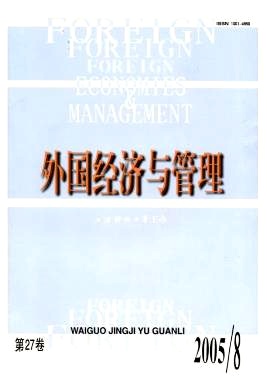国外组织创新气氛研究概述
外国经济与管理 2005 年 第 27 卷第 08 期, 页码:26 - 32
摘要
参考文献
摘要
本文在梳理国外相关研究文献的基础上,从组织创新气氛的概念内涵、结构与测量、形成过程、作用机制及其与创新绩效的关系等方面介绍了国外组织创新气氛研究的现状,并指出了研究存在的问题与未来的研究方向。
[1]Drucker P F. The discipline of innovation [J]. Harvard Business Review,1998,(Nov/Dec):149-157.
[2]Amabile T M. Creativity in context: update to the social psychology of creativity [M]. Boulder, Colo. Westview,1996.
[3]Tesluk P E, Farr J L, Klein S R. Influences of organizational culture and climate on individual creativity [J]. Journal ofCreative Behavior,1997,31:27-41.
[4]Bharadwaj S, Menon A. Making innovation happen in organizations: individual creativity mechanisms, organization crea-tivity mechanisms or both ?[J]. Journal of Production Innovation Management,2000,17:424-434.
[5]Kanter R M. Innovation: our only hope for times ahead?[J]. Sloan Management Review,1984,25:51-55.
[6]Raudsepp E. Establishing a creative climate [J]. Training and Development Journal,1987,41(4):50-53.
[7] Mathisen G E, Einarsen S, Jorstad K, Bronnick K S. Climate for work group creativity and innovation: Norwegian vali-dation of the team climate inventory (TCI)[J]. Scandinavian Journal of Psychology,2004,45(5):383-392.
[8]Mathisen G E, Einarsen S. A review of instruments assessing creative and innovative environments within organizations[J]. Creativity Research Journal,2004,16(1):119-140
[9]Lee M, Na D. Determinants of technical success in product development when innovative radicalness is considered [J].Journal of Product Innovation Management,1994,11:62-68.
[10] McGrath M. Product strategy for high-tech companies [R]. Bur Ridge, Irwin,1995.
[11]Amabile T M, Conti R, Coon H, Lazenby J,& Herron M. Assessing the work environment for creativity [J]. Acade-my of Management Journal,1996,39(5):1154-1184.
[12] Tidd J, Bessant J & Pavitt K. Management innovation: integrating technological, market and organizational change[M]. New York: John Wiley & Sons,1997.
[13]Bessant J, Cayn S. High-involvement innovation through management [J]. International Journal of Technology Man-agement,1997,14(1):7-28.
[14]Madhavan R, Grover R. From embedded knowledge to embodied knowledge: new product development as knowledgemanagement [J]. Journal of Marketing,1998,62(4):1-12.
[15]Scott G M. The new age of new product development: are we there?[J]. R & D Management,1998,28(4):225-237.
[16]Avlonitis G, Papastathopoulou P, Gounaris S. An empirically based typology of product innovativeness for new financialservices: success and failure scenarios [J]. Journal of Product Innovation Management,2001,18:324-342.
[17] Bain P G, Mann L, Pirola M A. The innovation imperative: the relationship between team climate, innovation, andperformance in research and development teams [J]. Small Group Research,2001,32(1):55-73.
[18]Johannessen J A, Olsen B, Olaisen J. Aspects of innovation theory based knowledge management [ J]. InternationalJournal of Information Management,1999,19:121-139.
[2]Amabile T M. Creativity in context: update to the social psychology of creativity [M]. Boulder, Colo. Westview,1996.
[3]Tesluk P E, Farr J L, Klein S R. Influences of organizational culture and climate on individual creativity [J]. Journal ofCreative Behavior,1997,31:27-41.
[4]Bharadwaj S, Menon A. Making innovation happen in organizations: individual creativity mechanisms, organization crea-tivity mechanisms or both ?[J]. Journal of Production Innovation Management,2000,17:424-434.
[5]Kanter R M. Innovation: our only hope for times ahead?[J]. Sloan Management Review,1984,25:51-55.
[6]Raudsepp E. Establishing a creative climate [J]. Training and Development Journal,1987,41(4):50-53.
[7] Mathisen G E, Einarsen S, Jorstad K, Bronnick K S. Climate for work group creativity and innovation: Norwegian vali-dation of the team climate inventory (TCI)[J]. Scandinavian Journal of Psychology,2004,45(5):383-392.
[8]Mathisen G E, Einarsen S. A review of instruments assessing creative and innovative environments within organizations[J]. Creativity Research Journal,2004,16(1):119-140
[9]Lee M, Na D. Determinants of technical success in product development when innovative radicalness is considered [J].Journal of Product Innovation Management,1994,11:62-68.
[10] McGrath M. Product strategy for high-tech companies [R]. Bur Ridge, Irwin,1995.
[11]Amabile T M, Conti R, Coon H, Lazenby J,& Herron M. Assessing the work environment for creativity [J]. Acade-my of Management Journal,1996,39(5):1154-1184.
[12] Tidd J, Bessant J & Pavitt K. Management innovation: integrating technological, market and organizational change[M]. New York: John Wiley & Sons,1997.
[13]Bessant J, Cayn S. High-involvement innovation through management [J]. International Journal of Technology Man-agement,1997,14(1):7-28.
[14]Madhavan R, Grover R. From embedded knowledge to embodied knowledge: new product development as knowledgemanagement [J]. Journal of Marketing,1998,62(4):1-12.
[15]Scott G M. The new age of new product development: are we there?[J]. R & D Management,1998,28(4):225-237.
[16]Avlonitis G, Papastathopoulou P, Gounaris S. An empirically based typology of product innovativeness for new financialservices: success and failure scenarios [J]. Journal of Product Innovation Management,2001,18:324-342.
[17] Bain P G, Mann L, Pirola M A. The innovation imperative: the relationship between team climate, innovation, andperformance in research and development teams [J]. Small Group Research,2001,32(1):55-73.
[18]Johannessen J A, Olsen B, Olaisen J. Aspects of innovation theory based knowledge management [ J]. InternationalJournal of Information Management,1999,19:121-139.
引用本文
王雁飞, 朱瑜. 国外组织创新气氛研究概述[J]. 外国经济与管理, 2005, 27(8): 26–32.
导出参考文献,格式为:
上一篇:组织气候研究回顾及展望
下一篇:企业经理报酬决定理论:争论与整合





 7372
7372  0
0

